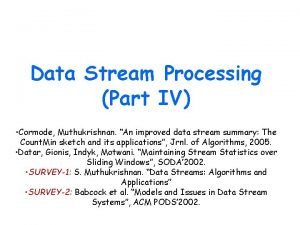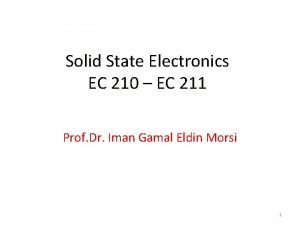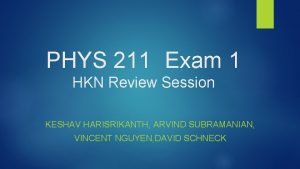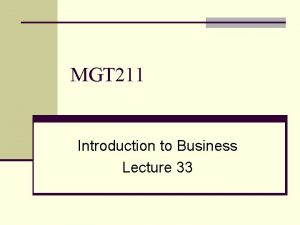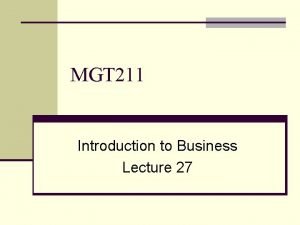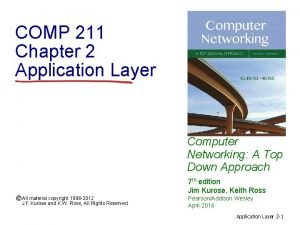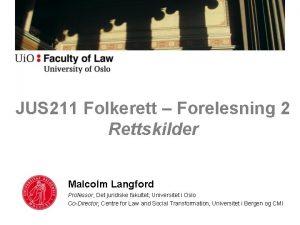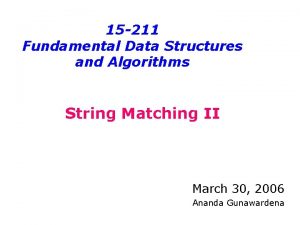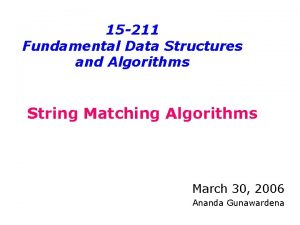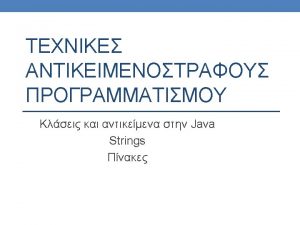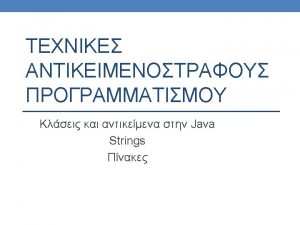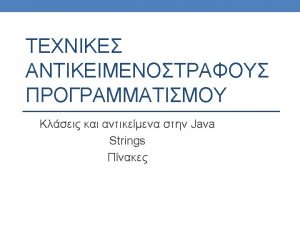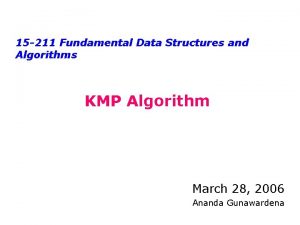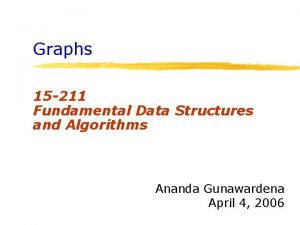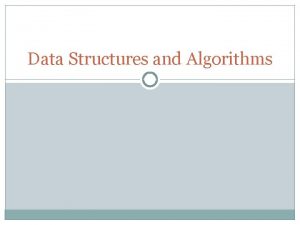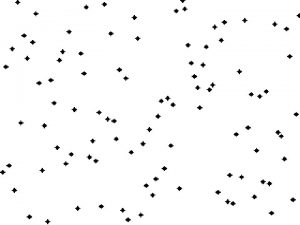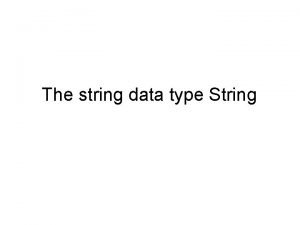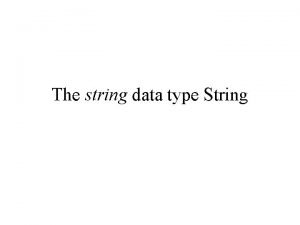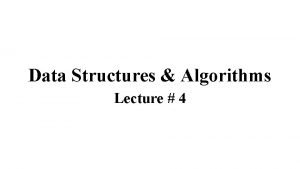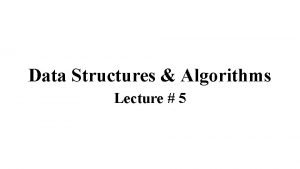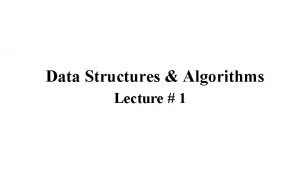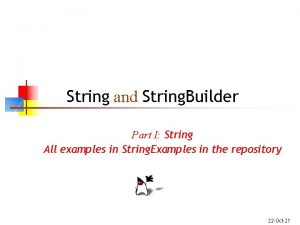15 211 Fundamental Data Structures and Algorithms String





![String Matching • Text string T[0. . N-1] T = “abacaabaccabaabb” • Pattern string String Matching • Text string T[0. . N-1] T = “abacaabaccabaabb” • Pattern string](https://slidetodoc.com/presentation_image_h/e0ff8fc5439d6513841cc35b6663d42f/image-6.jpg)




![Brute Force Version 1 static int match(char[] T, char[] P){ for (int i=0; i<T. Brute Force Version 1 static int match(char[] T, char[] P){ for (int i=0; i<T.](https://slidetodoc.com/presentation_image_h/e0ff8fc5439d6513841cc35b6663d42f/image-11.jpg)
![Brute Force, Version 2 static int match(char[] T, char[] P){ int n = T. Brute Force, Version 2 static int match(char[] T, char[] P){ int n = T.](https://slidetodoc.com/presentation_image_h/e0ff8fc5439d6513841cc35b6663d42f/image-12.jpg)















![Implementing KMP • Never decrement i, ever. – Comparing T[i] with P[j]. • Compute Implementing KMP • Never decrement i, ever. – Comparing T[i] with P[j]. • Compute](https://slidetodoc.com/presentation_image_h/e0ff8fc5439d6513841cc35b6663d42f/image-28.jpg)





![KMP pre-process Algorithm m = |P|; Define a table F of size m F[0] KMP pre-process Algorithm m = |P|; Define a table F of size m F[0]](https://slidetodoc.com/presentation_image_h/e0ff8fc5439d6513841cc35b6663d42f/image-34.jpg)






- Slides: 40

15 -211 Fundamental Data Structures and Algorithms String Matching March 28, 2006 Ananda Gunawardena

In this lecture • String Matching Problem – Concept – Regular expressions – brute force algorithm – complexity • Finite State Machines • Knuth-Morris-Pratt(KMP) Algorithm – Pre-processing – complexity

Pattern Matching Algorithms

The Problem • Given a text T and a pattern P, check whether P occurs in T – eg: T = {aabbcbbcabbbcbccccabbabbccc} – Find all occurrences of pattern P = bbc • There are variations of pattern matching – Finding “approximate” matchings – Finding multiple patterns etc. .

Why String Matching? • Applications in Computational Biology – DNA sequence is a long word (or text) over a 4 -letter alphabet – GTTTGAGTGGTCAGTCTTTTCGACGGAGCCCCCAATT AATAAACTCATAAGCAGACCTCAGTTCGCTTAGAGCAGCCG AAA…. . – Find a Specific pattern W • Finding patterns in documents formed using a large alphabet – Word processing – Web searching – Desktop search (Google, MSN) • Matching strings of bytes containing – Graphical data – Machine code • grep in unix – grep searches for lines matching a pattern.
![String Matching Text string T0 N1 T abacaabaccabaabb Pattern string String Matching • Text string T[0. . N-1] T = “abacaabaccabaabb” • Pattern string](https://slidetodoc.com/presentation_image_h/e0ff8fc5439d6513841cc35b6663d42f/image-6.jpg)
String Matching • Text string T[0. . N-1] T = “abacaabaccabaabb” • Pattern string P[0. . M-1] P = “abacab” • Where is the first instance of P in T? T[10. . 15] = P[0. . 5] • Typically N >>> M

Java Pattern Matching Utilities • Java provides an API for pattern matching with regular expressions – java. util. regex • Regular expressions describe a set of strings based on some common characteristics shared by each string in the set. eg: a* ={ , a, aaa, …} • Regular expressions can be used as a tool to search, edit or manipulate text or data – perl, java, C#

Java Pattern Matching Utilities • java. util. regex – Pattern • Is a compiled representation of a regular expression. • Eg: Pattern p = Pattern. compile("a*b"); – Matcher • A machine that performs match operations on a character sequence by interpreting a pattern. • Eg: Matcher m = p. matcher("aabbb"); • Example: public static void main( String args[] ) { Pattern p = Pattern. compile("(aa|bb)*"); Matcher m = p. matcher("aabbb"); boolean b = m. matches(); //match the entire input sequence against the pattern // or boolean b = m. find(); // match the entire input sequence against the pattern System. out. println("The value is " + b); }

String Matching abacaabaccabaabb abacab abacab abacab • The brute force algorithm • 22+6=28 comparisons.

Naïve Algorithm (or Brute Force) • Assume |T| = n and |P| = m Text T Pattern P Compare until a match is found. If so return the index where match occurs else return -1
![Brute Force Version 1 static int matchchar T char P for int i0 iT Brute Force Version 1 static int match(char[] T, char[] P){ for (int i=0; i<T.](https://slidetodoc.com/presentation_image_h/e0ff8fc5439d6513841cc35b6663d42f/image-11.jpg)
Brute Force Version 1 static int match(char[] T, char[] P){ for (int i=0; i<T. length; i++){ boolean flag = true; if (P[0]==T[i]) for (int j=1; j<P. length; j++) if (T[i+j]!=P[j]) {flag=false; break; } if (flag) return i; } } • What is the complexity of the code?
![Brute Force Version 2 static int matchchar T char P int n T Brute Force, Version 2 static int match(char[] T, char[] P){ int n = T.](https://slidetodoc.com/presentation_image_h/e0ff8fc5439d6513841cc35b6663d42f/image-12.jpg)
Brute Force, Version 2 static int match(char[] T, char[] P){ int n = T. length; int m = P. length; int i = 0; int j = 0; // rewrite the brute-force code with only one loop do { // Homework while (j<m && i<n); } • What is the complexity of your code?

A bad case 000000001 000000000000000000000000001 • 60+5 = 65 comparisons are needed • How many of them could be avoided?

A bad case 000000001 000000000000000000000000001 • 60+5 = 65 comparisons are needed • How many of them could be avoided?

Typical text matching This is a sample sentence - - • 20+5=25 comparisons are needed - s- - (The match is near the same point in the target string as the previous example. ) s- - • In practice, 0 j 2 - s- - - sente

String Matching • Brute force worst case – O(MN) – Expensive for long patterns in repetitive text • How to improve on this? • Intuition: – Remember what is learned from previous matches

Finite State Machines

Finite State Machines (FSM) • FSM is a computing machine that takes – A string as an input – Outputs YES/NO answer • That is, the machine “accepts” or “rejects” the string Yes / No Input String FSM

FSM Model • Input to a FSM – Strings built from a fixed alphabet {a, b, c} – Possible inputs: aa, aabbcc, a etc. . • The Machine – A directed graph • Nodes = States of the machine • Edges = Transition from one state to another o 1

FSM Model • Special States – Start (q 0) and Final (or Accepting) (q 2) • Assume the alphabet is {a, b} – Which strings are accepted by this FSM?

FSM Model • Exercise: draw a finite automaton that accepts any string with “even” number of 1’s • Exercise: draw a finite automaton that accepts any string with “even” number of consecutive 1’s followed by “odd” number of consecutive zeros

Why Study FSM’s • Useful Algorithm Design Technique – Lexical Analysis (“tokenization”) – Control Systems • Elevators, Soda Machines…. • Modeling a problem with FSM is – Simple – Elegant

State Transitions • Let Q be the set of states and ∑ be the alphabet. Then the transition function T is given by – T: Q x ∑ Q • ∑ could be – – {0, 1} – binary {C, G, T, A} – nucleotide base {0, 1, 2, . . , 9, a, b, c, d, e, f} – hexadecimal etc. . • Eg: Consider ∑ ={a, b, c} and P=aabc – set of states are all prefixes of P – Q = { , a, aab, aabc} or – Q = {0 1 2 3 4 } • State transitions T(0, ’a’) = 1; T(1, ‘a’) = 2, etc… • What about failure transitions?

Failure Transitions • Where do we go when a failure occurs? • P=“aabc” • Q – current state • Q’ – next state • initial state = 0 • end state = 4 • How to store state transition table? – as a matrix Q ∑ Q’ 0 a {b, c} 1 0 1 a {b, c} 2 0 2 b a c 3 2 0 3 c a b 4 1 0

Using FSM concept in Pattern Matching • Consider the alphabet {a, b, c} • Suppose we are looking for pattern “aabc” • Construct a finite automaton for “aabc” as follows a a b|c Start 0 a 1 b|c a b 2 c b 3 c 4

Knuth Morris Pratt (KMP) Algorithm

KMP – The Big Idea • Retain information from prior attempts. • Compute in advance how far to jump in P when a match fails. – Suppose the match fails at P[j] T[i+j]. – Then we know P[0. . j-1] = T[i. . i+j-1]. • We must next try P[0] ? T[i+1]. – But we know T[i+1]=P[1] – What if we compare: P[1]? P[0] • If so, increment j by 1. No need to look at T. – What if P[1]=P[0] and P[2]=P[1]? • Then increment j by 2. Again, no need to look at T. • In general, we can determine how far to jump without any knowledge of T!
![Implementing KMP Never decrement i ever Comparing Ti with Pj Compute Implementing KMP • Never decrement i, ever. – Comparing T[i] with P[j]. • Compute](https://slidetodoc.com/presentation_image_h/e0ff8fc5439d6513841cc35b6663d42f/image-28.jpg)
Implementing KMP • Never decrement i, ever. – Comparing T[i] with P[j]. • Compute a table f of how far to jump j forward when a match fails. – The next match will compare T[i] with P[f[j-1]] • Do this by matching P against itself in all positions.

Building the Table for f • P = 1010011 • Find self-overlaps Prefix 1 10 101001 1010011 Overlap. . 1 10. 1 1 j 1 2 3 4 5 6 7 f 0 0 1 2 0 1 1

What f means Prefix Overlap 1. 101 1 1010 10 101001 1 1010011 1 j 1 2 3 4 5 6 7 f 0 0 1 2 0 1 1 • If f is zero, there is no self-match. – Set j=0 – Do not change i. • The next match is T[i] ? P[0] • f non-zero implies there is a self-match. E. g. , f=2 means P[0. . 1] = P[j 2. . j-1] • Hence must start new comparison at j-2, since we know T[i-2. . i-1] = P[0. . 1] In general: – Set j=f[j-1] – Do not change i. • The next match is T[i] ? P[f[j-1]]

Favorable conditions • P = 1234567 • Find self-overlaps Prefix 1 12 123456 1234567 Overlap. . . . j 1 2 3 4 5 6 7 f 0 0 0 0

Mixed conditions • P = 1231234 • Find self-overlaps Prefix 1 12 123123 1231234 Overlap. . . 1 12 123. j 1 2 3 4 5 6 7 f 0 0 0 1 2 3 0

Poor conditions • P = 1111110 • Find self-overlaps Prefix 1 11 111111 1111110 Overlap. 1 11 11111. j 1 2 3 4 5 6 7 f 0 1 2 3 4 5 0
![KMP preprocess Algorithm m P Define a table F of size m F0 KMP pre-process Algorithm m = |P|; Define a table F of size m F[0]](https://slidetodoc.com/presentation_image_h/e0ff8fc5439d6513841cc35b6663d42f/image-34.jpg)
KMP pre-process Algorithm m = |P|; Define a table F of size m F[0] = 0; i = 1; j = 0; while(i<m) { compare P[i] and P[j]; if(P[j]==P[i]) { F[i] = j+1; i++; j++; } else if (j>0) j=F[j-1]; else {F[i] = 0; i++; } } Use previous values of f

KMP Algorithm input: Text T and Pattern P |T| = n |P| = m Compute Table F for Pattern P i=j=0 while(i<n) { if(P[j]==T[i]) { if (j==m-1) return i-m+1; i++; j++; } else if (j>0) j=F[j-1]; else i++; Use F to determine next value for j. } output: first occurrence of P in T

Specializing the matcher Prefix Overlap 1. 101 1 1010 10 101001 1 1010011 1 1 0 j 1 2 3 4 5 6 7 0 0 f 0 0 1 2 0 1 1 . 0 0 1 0 0 0 1 1 0

Brute Force KMP 00000000000001 0000000000000000000000000000000000000000000000000000000000000000000000000000000000000000000 - 000000000000001 • A worse case example: 196 + 14 = 210 comparisons 28+14 = 42 comparisons 000000000000001

Brute Force KMP abcdeabcdeabcedfghijkl - bc- bc- - bcedfg 21 comparisons 19 comparisons 5 preparation comparisons

KMP Performance • Pre-processing needs O(M) operations. • At each iteration, one of three cases: – T[i] = P[j] • i increases – T[i] <> P[j] and j>0 • i-j increases – T[I] <> P[j] and j=0 • i increases and i-j increases • Hence, maximum of 2 N iterations. • Thus worst case performance is O(N+M).

Exercises • Suppose we are given the pattern P = 10010001 and • text T = 00010010010111 • do the following – Draw a FSM for pattern P – Construct the KMP table for P – Trace the KMP algorithm with T
 Licenseid=string&content=string&/paramsxml=string
Licenseid=string&content=string&/paramsxml=string Professor ajit diwan
Professor ajit diwan Amit agarwal princeton
Amit agarwal princeton Data structures and algorithms tutorial
Data structures and algorithms tutorial Information retrieval data structures and algorithms
Information retrieval data structures and algorithms Data structures and algorithms bits pilani
Data structures and algorithms bits pilani Ajit diwan iit bombay
Ajit diwan iit bombay Data structures and algorithms
Data structures and algorithms Data structures and algorithms
Data structures and algorithms Waterloo data structures and algorithms
Waterloo data structures and algorithms Information retrieval data structures and algorithms
Information retrieval data structures and algorithms Data structures and algorithms
Data structures and algorithms Algorithms + data structures = programs
Algorithms + data structures = programs![Const int size=18; string *tb12 = new string[size]; Const int size=18; string *tb12 = new string[size];](data:image/svg+xml,%3Csvg%20xmlns=%22http://www.w3.org/2000/svg%22%20viewBox=%220%200%20200%20200%22%3E%3C/svg%3E) Const int size=18; string *tb12 = new string[size];
Const int size=18; string *tb12 = new string[size]; Public class plant private string name
Public class plant private string name Str string
Str string Homologous
Homologous Data stream
Data stream Opwekking 211
Opwekking 211 Miller indices 211
Miller indices 211 Coordinated entry snohomish county
Coordinated entry snohomish county Poli 211
Poli 211 Physics 211 exam 1
Physics 211 exam 1 Legea 211/2011
Legea 211/2011 Mgt 211
Mgt 211 A product can be
A product can be Is 211 nationwide
Is 211 nationwide Csce 211
Csce 211 211 taxonomy
211 taxonomy Trigo buck colihue
Trigo buck colihue Csce 211
Csce 211 Comp 211
Comp 211 Comp 211
Comp 211 Comp 211
Comp 211 211 org md
211 org md 매트랩 subplot
매트랩 subplot Nur 211 final exam
Nur 211 final exam Supportability analysis
Supportability analysis Log 211
Log 211 Jus 211
Jus 211 Ochmis
Ochmis













![Const int size=18; string *tb12 = new string[size]; Const int size=18; string *tb12 = new string[size];](https://slidetodoc.com/wp-content/uploads/2020/11/1588947_40cf3415d0afabae1c436a49b39f4ad0-300x225.jpg)



